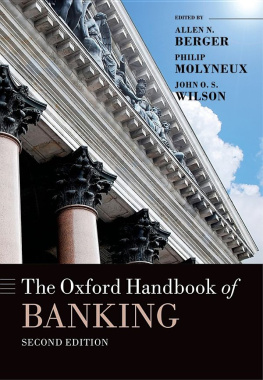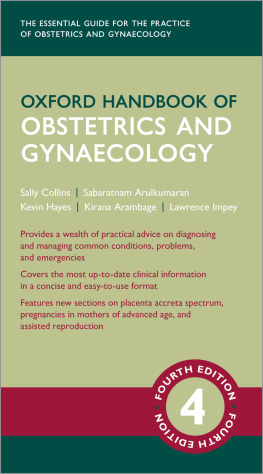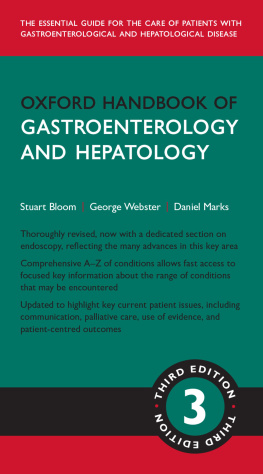Allen N. Berger (editor) - The Oxford Handbook of Banking
Here you can read online Allen N. Berger (editor) - The Oxford Handbook of Banking full text of the book (entire story) in english for free. Download pdf and epub, get meaning, cover and reviews about this ebook. City: Oxford, year: 2014, publisher: Oxford University Press, genre: Science. Description of the work, (preface) as well as reviews are available. Best literature library LitArk.com created for fans of good reading and offers a wide selection of genres:
Romance novel
Science fiction
Adventure
Detective
Science
History
Home and family
Prose
Art
Politics
Computer
Non-fiction
Religion
Business
Children
Humor
Choose a favorite category and find really read worthwhile books. Enjoy immersion in the world of imagination, feel the emotions of the characters or learn something new for yourself, make an fascinating discovery.
- Book:The Oxford Handbook of Banking
- Author:
- Publisher:Oxford University Press
- Genre:
- Year:2014
- City:Oxford
- Rating:4 / 5
- Favourites:Add to favourites
- Your mark:
- 80
- 1
- 2
- 3
- 4
- 5
The Oxford Handbook of Banking: summary, description and annotation
We offer to read an annotation, description, summary or preface (depends on what the author of the book "The Oxford Handbook of Banking" wrote himself). If you haven't found the necessary information about the book — write in the comments, we will try to find it.
The Oxford Handbook of Banking — read online for free the complete book (whole text) full work
Below is the text of the book, divided by pages. System saving the place of the last page read, allows you to conveniently read the book "The Oxford Handbook of Banking" online for free, without having to search again every time where you left off. Put a bookmark, and you can go to the page where you finished reading at any time.
Font size:
Interval:
Bookmark:

Great Clarendon Street, Oxford, OX2 6DP, United Kingdom
Oxford University Press is a department of the University of Oxford.
It furthers the Universitys objective of excellence in research, scholarship, and education by publishing worldwide. Oxford is a registered trade mark of Oxford University Press in the UK and in certain other countries
Oxford University Press 2015
Chapter 16 illustrations
Federal Reserve Bank of New York
The moral rights of the authors have been asserted
First Edition published in 2010
Second Edition published in 2015
Impression: 1
All rights reserved. No part of this publication may be reproduced, stored in a retrieval system, or transmitted, in any form or by any means, without the prior permission in writing of Oxford University Press, or as expressly permitted by law, by licence or under terms agreed with the appropriate reprographics rights organization. Enquiries concerning reproduction outside the scope of the above should be sent to the Rights Department, Oxford University Press, at the address above
The authors of Chapters 16, 23, and 33 are employees of the U.S. government and prepared portions of the work as part of their official duties. These chapters are United States Government work.
You must not circulate this work in any other form and you must impose this same condition on any acquirer
Published in the United States of America by Oxford University Press
198 Madison Avenue, New York, NY 10016, United States of America
British Library Cataloguing in Publication Data
Data available
Library of Congress Control Number: 2014939132
ISBN 9780199688500
eISBN 9780191002205
Links to third party websites are provided by Oxford in good faith and for information only. Oxford disclaims any responsibility for the materials contained in any third party website referenced in this work.
For Mindy (Allen N. Berger)
For Delyth, Alun, Gareth, Gethin, Catrin,
Lois, and Rhiannon (Philip Molyneux)
For Alison, Kathryn, Elizabeth, and Jean (John O. S. Wilson)
Since, the publication of the first edition of the Oxford Handbook of Banking in 2010, banking systems around the world have continued to be affected by the recent financial crisis which began in 2007. There have been wide-ranging regulatory reforms aimed at containing their risk-taking capabilities. Regulatory reform has been most marked in the US with the passing of the landmark DoddFrank Act of 2010, which aims to eliminate too-big-to-fail and the implicit taxpayer bailouts of major banks. The Act also seeks to reduce the risk-taking capacity of banks by limiting proprietary trading and other volatile business areas, embodied in the Volcker Rule. Similar major reforms are ongoing throughout the European Union following the Liikanen Report of 2012 and the Vickers Report of 2011, both of which aim to segregate or ring-fence banks risky securities activities from less volatile retail banking operations. Coupled with this is the desire to bolster regulatory oversight as well as to force institutions to hold more capital and liquidity. The latter two are encapsulated by the Basel III reforms that national legislators are expected to put fully into place by 2019.
In addition to the turmoil associated with the recent financial crisis, Europe has also experienced a sovereign debt crisis, where weak banking systems and excessive government indebtedness have led to sovereign bailouts of Greece, Ireland, Spain, and Portugal (the so-called euro periphery countries). This has had implications for the credibility of the European single currency and policy conducted by the European Central Bank. It has also led to the recognition that bank and sovereign risks are inextricably linked.
The second edition is substantially updated and changed from the first edition, with at least 40% new material, reflecting the unprecedented changes that have occurred in global banking systems. This new edition provides the reader with a timely and comprehensive overview and analysis of many of these developments. The authors of the following 40 chapters comprise a collection of leading academics and policymakers in the field. These authors emanate from universities in North America, Europe, South America, and Asia; the US Federal Reserve System; the Office of the Comptroller of Currency; the Central Bank of Ireland, the European Central Bank; the World Bank; and the International Monetary Fund. The book strikes a balance among abstract theory, empirical research, practitioner analysis, and policy-related material. Chapters in the handbook have different emphases on these four ingredients. We hope that the contributions contained here set the stage for future research and policy debate for many years to come.
Allen N. Berger
Philip Molyneux
and John O. S. Wilson
October, 2014
First, and most important, we wish to thank the contributors to the handbook. We are delighted to have brought together such an outstanding set of research experts from academic and policy arenas across Europe, North America, South America, and Asia. These experts have shown a high level of commitment and perseverance to the project from beginning to end. Without their expertise, dedication, and efficiency in producing scholarly banking chapters, this handbook would never have been possible.
The production of this handbook has also relied heavily on the exceptional enthusiasm and commitment of Oxford University Press, most notably Adam Swallow, publisher for Economics and Finance, who was crucial in helping us kick-start the project. Oxford University Press delegates and a number of anonymous referees also played an important role in advising on the shape of the handbook. We would also like to especially thank and acknowledge the advice of Aimee Wright, who was always on hand to help and worked closely with us throughout the entire process. The team in New York also played a valuable role, and so wed like to thank Michael De La Cruz and Lauren Konopko. The editors would particularly like to thank Elizabeth Stone, copy-editor, for doing an excellent job on the submitted manuscript. Carol Carnegie and Saipriya Kannan also played a crucial role toward the end of the project, and our proof reader, Denise Bannerman, provided invaluable service.
We would also like to acknowledge the support of our home institutions: the Moore School of Business at University of South Carolina, the Business School at Bangor University, and the Management School at University of St Andrews.
A number of individuals provided comments to us on the content and style on parts of the handbook, including Barbara Casu, Mark Flannery, Claudia Girardone, John Goddard, Dick Herring, Ed Kane, Jos Liares-Zegarra, Donal McKillop, Joe Peek, and Larry White. A big thank you goes to them all.
Finally, we would like to thank our families and friends for their encouragement and patience over the last two years while we completed this handbook. Their support is much appreciated.
ALLEN N. BERGER, PHILIP MOLYNEUX, AND JOHN O. S. WILSON
FRANKLIN ALLEN, ELENA CARLETTI, AND XIAN GU
ARNOUD W. A. BOOT AND ANJAN V. THAKOR
RICHARD J. HERRING AND JACOPO CARMASSI
ALAN D. MORRISON
JENS HAGENDORFF
LINDA ALLEN AND ANTHONY SAUNDERS
CHRISTA H. S. BOUWMAN
KEVIN J. STIROH
JOSEPH P. HUGHES AND LORETTA J. MESTER
W. SCOTT FRAME AND LAWRENCE J. WHITE
ALLEN N. BERGER
THOMAS A. DURKIN AND GREGORY ELLIEHAUSEN
Font size:
Interval:
Bookmark:
Similar books «The Oxford Handbook of Banking»
Look at similar books to The Oxford Handbook of Banking. We have selected literature similar in name and meaning in the hope of providing readers with more options to find new, interesting, not yet read works.
Discussion, reviews of the book The Oxford Handbook of Banking and just readers' own opinions. Leave your comments, write what you think about the work, its meaning or the main characters. Specify what exactly you liked and what you didn't like, and why you think so.











